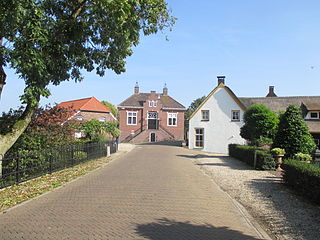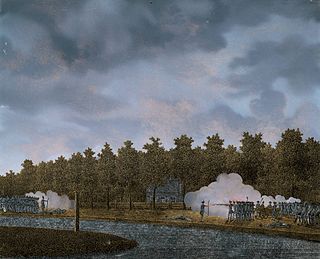
Druten is a municipality and a town in the eastern Netherlands. The municipality covers the eastern part of the Land van Maas en Waal region of the province of Gelderland.

West Maas en Waal is a municipality in the Dutch province of Gelderland.

Molenhoek is a village located in south-eastern Netherlands partially in the municipality of Mook en Middelaar in the province of Limburg and partially in the municipality of Heumen in the province of Gelderland. It is also the northernmost town of Limburg and thus its nickname is "De Poort van Limburg".

The Bijlands Kanaal is a canal in the Dutch province of Gelderland, near the Dutch-German border. It is currently by far the most important river-stretch of the Rhine when that major river enters the Netherlands.

Heiligerlee is a village in the Dutch province of Groningen bordering the town of Winschoten, it is part of the municipality of Oldambt. It was the site of the 1536 Battle and the 1568 Battle of Heiligerlee

Varsseveld is a town in the Netherlands, located in the Dutch municipality of Oude IJsselstreek.

The Dutch Waterline was a series of water-based defences conceived by Maurice of Nassau in the early 17th century, and realised by his half brother Frederick Henry. Combined with natural bodies of water, the Waterline could be used to transform Holland, the westernmost region of the Netherlands and adjacent to the North Sea, almost into an island. In the 19th century, the Line was extended to include Utrecht.

The (First) Battle of Vlaardingen was fought on 29 July 1018 between troops of the Holy Roman Empire and West Frisia. As a result of a trade dispute, Emperor Henry II sent an army towards West Frisia to subdue the rebellious Count Dirk III. However, the Imperial army was decisively defeated and fled in panic.

Nicky Hofs is a Dutch former professional footballer who played as a midfielder. He spent most of his professional career with Vitesse. After retiring, he began working as a youth and assistant coach within the Vitesse organisation.

Haaften is a village in the Dutch province of Gelderland, on the northern shore of the river Waal, about opposite Zaltbommel. It is a part of the municipality of West Betuwe, and lies about 25 km south of Utrecht.

Maasbommel is a city in the Dutch province of Gelderland. It is a part of the municipality of West Maas en Waal, and lies about 7 km north of Oss. It received city rights in 1312.

Corneli(u)s Rudolphus Theodorus, Baron Krayenhoff was a physicist, artist, general, hydraulic engineer, cartographer and – against his will and for only a short time – Dutch Minister of War.

Jan Geurt Siebelink is a Dutch author. In 2005, he wrote the novel Knielen op een bed violen that sold over 700,000 copies. In 1991, he won the Ferdinand Bordewijk Prijs for De overkant van de rivier.

The Low Countries theatre of the War of the First Coalition, in British historiography better known as the Flanders campaign, was a series of campaigns in the Low Countries conducted from 20 April 1792 to 7 June 1795 during the first years of the War of the First Coalition. As the French Revolution radicalised, the revolutionary National Convention and its predecessors broke the Catholic Church's power (1790), abolished the monarchy (1792) and even executed the deposed king Louis XVI of France (1793), vying to spread the Revolution beyond the new French Republic's borders, by violent means if necessary. The First Coalition, an alliance of reactionary states representing the Ancien Régime in Central and Western Europe – Habsburg Austria, Prussia, Great Britain, the Dutch Republic, Hanover and Hesse-Kassel – mobilised military forces along all the French frontiers, threatening to invade Revolutionary France and violently restore the monarchy. The subsequent combat operations along the French borders with the Low Countries and Germany became the primary theatre of the War of the First Coalition until March 1796, when Napoleon took over French command on the Italian front.

The Admiraal Tjerk Hiddes de Vries was a Dutch 68-gun third rate ship of the line of the navy of the Admiralty of Friesland, one of five provincial naval forces of the United Republic of the Netherlands' In 1795, following the French occupation of the Netherlands, this ship was taken over by the Batavian Republic, and in 1797 was captured by the Royal Navy.

Doornik is a hamlet in the municipality of Lingewaard, between Lent and Bemmel, in the province of Gelderland, the Netherlands. Most of Doornik was destroyed at a Dyke breach in 1799, the village never recovered. Doornik had an own castle which burned down in 1823.

The Battle of Jutphaas, also known as the Battle of the Vaart or the Battle of Vreeswijk, occurred on 9 May 1787 on the banks of the Vaartsche Rijn canal near Jutphaas and Vreeswijk between Orangists and Patriots.

The siege of Nijmegen occurred from 27 October to 8 November 1794 during the Flanders campaign of the War of the First Coalition. It was the last major military confrontation between the forces of the Revolutionary French First Republic and the reactionary First Coalition of European monarchs including William V, Prince of Orange, before the fall of the Dutch Republic in January 1795, which William had ruled as hereditary stadtholder since 1751. As commander-in-chief of the Dutch States Army, his indecision, several changes of mind and lack of coordination with his Anglo-Hanoverian, Hessian, Prussian and Austrian allies contributed to the eventual surrender of Nijmegen to the French revolutionaries.

Moordhuizen is a hamlet in the Dutch province of Gelderland. It is a part of the municipality of West Maas en Waal and is located about 3 kilometres (1.9 mi) from Alphen. The hamlet is notable for its name, and is the location of the Quarles van Ufford pumping station.
The evacuation of Arnhem was the departure, forcibly conducted by the German Wehrmacht, of tens of thousands of inhabitants of the Dutch city of Arnhem and nearby places from 23 to 25 September 1944 during the Battle of Arnhem in World War II. The occupying German forces decided to evacuate almost the entire civilian population in order to better defend the city against the Allied Operation Market Garden. After the city was evacuated, many houses and other buildings were looted by various groups of organised and unorganised German soldiers and pro-German collaborators.


















